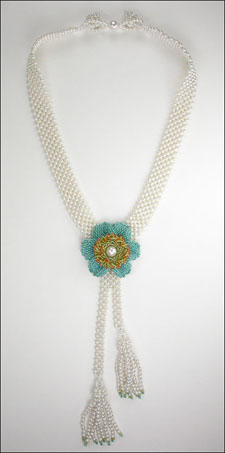|
Description: |
The
Imperial families of Russia were avid collectors of fine
jewelry, objets d’art, furnishings and glass. Up until the
Russian Revolution in 1917, the House of Fabergé was the
primary imperial jeweler to the Tsars. With the delivery of
the first imperial Easter egg in 1885 to Alexander III, the
House of Faberge´ received its imperial warrant. During the
reign of Nicholas II, Fabergé’s commission doubled as the
new tsar wished to give an egg every year to his mother
(Maria Feodorovna) and his wife, Empress Alexandra
Feodorovna. As well as being masterpieces of elegance and
refinement, the imperial eggs were tours de force of
technical virtuosity. The collection that ensued is amazing!
Alexandra’s Sautoir is my interpretation of the floral
aspects of the imperial eggs and the bejeweled flowers that
were Fabergé’s specialty. A single dimensional stylized
flower reigns supreme on a background of pearls. The
necklace evokes the style of the early 1900’s pearl Sautoir
necklaces, but with a contemporary look.
The
flower center uses tubular Peyote stitch with increasing to
create the flower center, the attaching area for the petals
and the smoothly shaped back of the flower. Two drop Peyote
stitched and color graded petals are attached to the center
of the flower, delivering dimensional effects. The flower
rests center front on a Right Angle Weave necklace chain
that ends in the front with two tassels and in the back with
two buttons and a connector. |

